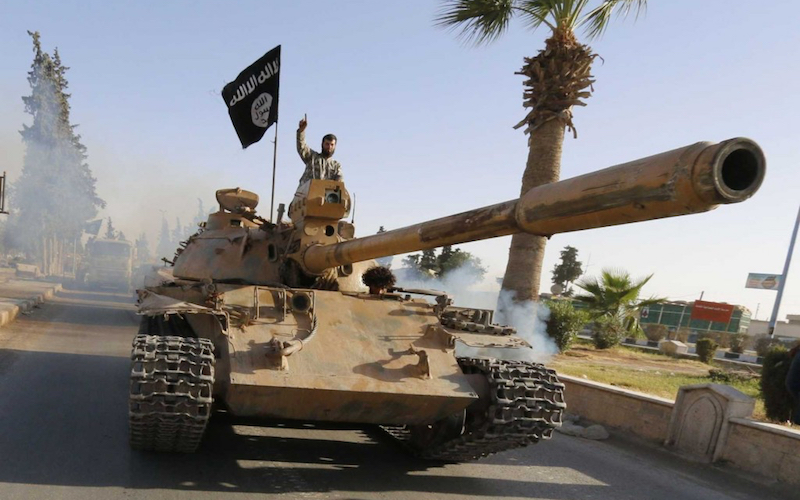
The Almost Indomitable Islamic State
The Islamic State has been making major inroads into various parts of the Middle East, posing colossal threats to the stability of many governments throughout the region. It, the Islamic State, has not only solidified its grip on power in Iraq and Syria, but also in certain areas of the Central Asian countries. Because of its swift and fast spread, and despite much attention on its modus operandi, it remains an enigma to many observers.
The reason for such mystery or uncertainty concerning the Islamic State is: how can such a group rise to power so quickly without major intelligence agencies from around the world taking notice and sounding the alarms? Where did the Islamic State come from? How could it amass so much wealth, power, influence, and other coercion devices in such a short period of time? These are questions that pervade throughout a newly published book, ISIS: The State of Terror, by Jessica Stern and J.M. Berger. Jessica Stern and J.M. Berger are both seasoned researchers on al-Qaeda and other terror groups around the world.
Many theories abound as to how the Islamic State sprang into existence. Some, Stern and Berger write, believe that the Islamic State came out of the regional rivalries between neighboring countries over access to oil, natural gas, and pipelines. While this theory seems to carry some weight at first sight, it does not hold much validity upon closer scrutiny. Competition over and the struggle for domination of the oil wells and natural gas reserves have been going on in Central Asia for decades. However, no such destructive force has risen to challenge various competing groups in such a violent way in Central Asia.
Some believe that the Islamic State’s rise can be attributed to poor governance and lack of democratic institutions in the Middle East, an assessment that is pretty close to the reality.
Another view which asserts that the Islamic State is a result of the proxy war between Iran and Saudi Arabia over regional dominance. Even though there is some truth to such a claim, I cannot see how such a violent, barbaric, and destructive competition can benefit either Iran or Saudi Arabia.
Stern and Berger are on point when they write: “What we know today is that ISIS emerged from the mind of Abu al Zarqawi, a Jordanian thug-turned-terrorist who brought a particularly brutal and sectarian approach to his understanding of jihad. Many factors contributed to the rise of ISIS, but its roots lie with Zarqawi and the 2003 invasion of Iraq that gave him purpose.” Many politically unrecognized, economically unemployed, and spiritually bankrupt youth across Iraq and the Middle East found Zarqawi’s twisted vision of a Shia-free, “pure” Islamic state appealing. Zarqawi’s message and method especially resonated with former Ba’athist party members.
The rise and the spread of the Islamic State could have been avoided, had Prime Minister Nour al-Maliki politically integrated Sunni Iraqis into his government. Stern and Berger write: “Rather than attempting to reduce Sunni’s feelings of disenfranchisement, Maliki began to purge the government of prominent Sunnis, further increasing sectarian tensions. He brought terrorism charges against his popular finance minister and a Sunni Arab parliamentarian.” In light of Maliki’s explicit political indifference and even antagonism toward Sunnis, Iraqi Sunnis found themselves isolated and deprived of many political and economic advantages. Stern and Berger quote Patrick Cockburn, a seasoned reporter on the Middle East, who proposes: “Mr. Maliki is not to blame for everything that has gone wrong in Iraq, but he played a central role in pushing the Sunni community into the arms of ISIS.”
A share of the blame for the rise of the Islamic State can be assigned to President Obama’s indifference and underestimation of the dangers posed by this group. Stern and Berger go on to note that as late as 2014, the president ignored the grave threats posed by the Islamic State. In an interview with the New Yorker, they write, President Obama went on to say: “The analogy we use around here sometimes, and I think is accurate, is if a jayvee team puts on Lakers uniforms that doesn’t make them Kobe Bryant. I think there is a distinction between the capacity and reach of a bin Laden and a network that is actively planning major terrorist plots against the homeland versus jihadists who are engaged in various local struggles and disputes, often sectarian.” Devoid of strategic farsightedness and preparedness to respond to the Islamic State, the Obama Administration was caught off guard and has yet to formulate a comprehensive strategic plan to annihilate the Islamic State.
Having amassed large amounts of cash and arms, the Islamic State fields somewhere around 25,000 fighters. The Arab Spring provided the Islamic State with a great number of disillusioned young men who were fed up with the appalling conditions effected by their authoritarian rulers. Among the Islamic State’s ranks there are also thousands of Sunni Ba’athists who were removed from power after the collapse of Saddam Hussein’s regime. Angry, unemployed, and without any purpose in their lives, Ba’athists have joined the Islamic State’s forces to topple the Shia’s regime in Baghdad. In addition, Stern and Berger cite Charles Lister of the Brookings institution according to whom, “ISIS controls territory from the Aleppo region of Syria to the Salah ad Din province in Iraq, an area larger than the United Kingdom.”
It’s not only the great number of fighters, the amount of wealth, and the vast swaths of territory at the Islamic State’s disposal that makes it so dangerous, but also its mastery over the strategic use of social media. Through Twitter and Facebook and other social media devices, the Islamic State has been recruiting thousands of European and North American Muslims. On June 3, 2015, counterterrorism officials in the United States killed Usaamah Rahim who had been recruited through social media and instructed by the Islamic State to kill law enforcement officials here in the United States. We are likely to see more such disillusioned young men, inspired by the Islamic State’s message, attempting to engage in violence here in the United States. Never before has a terrorist group been able to establish such mastery and control over social media and actively recruit individuals to fight for it. In a briefing to the House Homeland Security Committee, Michael Steinbach, assistant director of the FBI’s counterterrorism division, said: “The foreign terrorist now has direct access into the United States like never before.”
Social media and technology has transformed the world in ways that presents security officials with all sorts of dilemmas all around the world. What complicates things even further is the growth of smart mobs. Howard Rheingold, a technologist is credited by Stern and Berger with defining smart mobs as such: “Smart mobs consist of people who are able to act in concert even if they don’t know each other. The people who make up smart mobs cooperate in ways never before possible because they carry devices that possess both communication and computing abilities. Their mobile devices connect them with other information devices in the environment as well as other people’s telephones.”
Stern and Berger conclude their book on a gloomy note: the Islamic State has transformed itself into a lethal force — one that will be around for a long time. They believe that part of the Islamic State’s “apocalyptic plan had always included a confrontation with the West, and it has stretched its influence out both virtually and physically in preparation for a new phase of war.” Defeating and annihilating the Islamic State requires a concerted effort. Ultimately, however, it’s the Muslim world that must combine forces and counter the Islamic State and all that it represents. King Abdullah of Jordan put it right: “This is a Muslim problem. We need to take ownership of this. We need to stand up [to the Islamic State] and say what is right and what is wrong.” Given the chaotic state of the Arab world, it’s hard for them to form a better, liberal, and secular narrative to counter that of the Islamic State’s. The United States is armed with all sorts of advanced technologies and weaponries; therefore, it must lead the world in fighting and destroying the Islamic State. Whether the Obama Administration has gone beyond the javyvee analogy and is whole-heartedly committed to putting an end to the Islamic State remains to be seen.

